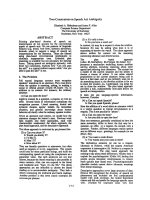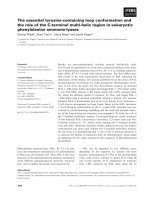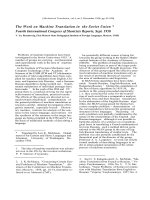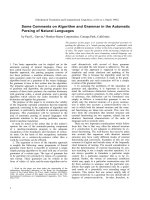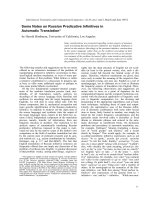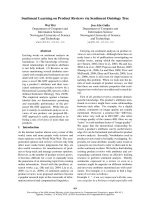Báo cáo khoa học: "gelling agents on growth, mineral composition and naphthoquinone content of in vitro explants of hybrid walnut tree (Juglans regia x Juglans nigra)" pdf
Bạn đang xem bản rút gọn của tài liệu. Xem và tải ngay bản đầy đủ của tài liệu tại đây (457.91 KB, 10 trang )
Original
article
Effects
of
gelling
agents
on
growth,
mineral
composition
and
naphthoquinone
content
of
in
vitro
explants
of
hybrid
walnut
tree
(Juglans
regia
x
Juglans
nigra)
E
Barbas
C
Jay-Allemand
P
Doumas
S Chaillou
D
Cornu
1
INRA,
Station
d’Amélioration
des
Arbres
Forestiers,
45160
Olivet;
2
INRA,
Laboratoire
du
Métabolisme
et
de
la
Nutrition
des
Plantes,
78000
Versailles,
France
(Received
15
May
1992;
accepted
22
October
1992)
Summary —
Gelling
agents
affect
growth
of
walnut
in
vitro
cultured
shoots.
Gelrite
promoted
shoot
elongation
and
bud
production,
whereas
agar
inhibited
growth,
induced
mature
leaf
formation
and
necroses.
The
2
gelling
agents
differed
significantly
in
mineral
content.
They
altered
the
chemical
composition
of
the
medium
as
well
as
that
of
the
explants.
A
pronounced
accumulation
of
Na
and
several
microelements
was
observed
in
leaves
after
16
d
of
culture
on
agar,
probably
due
to
a
dis-
turbance
in
the
K
selectivity
mechanism
and
membrane
permeability.
Moreover,
on
agar,
the
level
of
hydrojuglone
glucoside,
a
marker
of
juvenility
in
walnut,
decreased
drastically
in
the
callus.
Mineral
element
accumulation
and
decrease
of
hydrojuglone
glucoside
were
evident
after
growth
inhibition,
indicating
that
they
are
a
result
rather
than
a
cause
of
this
inhibition.
Lack
of
growth,
mature
foliar
morphology,
Na
and
microelement
accumulation
and
hydrojuglone
glucoside
decline
support
the
hy-
pothesis
that
agar
accelerates
the
ageing
of
in
vitro
propagated
walnut
trees.
Juglans
/
micropropagation
/
gelling
agent
/
mineral
composition
Résumé —
Effets
des
agents
de
solidification
du
milieu
de
culture
sur
la
croissance,
la
com-
position
minérale
et
la
teneur
en
hydrojuglone
glucoside
des
explants
de
noyer
hybride
culti-
vés
in
vitro.
Les
agents
de
solidification
influent
sur
la
croissance
des
pousses
du
noyer
cultivées
in
vitro
(fig
1).
La
gelrite
a
un
effet
bénéfique
sur
l’élongation
des
explants
et
la
production
de
bour-
geons,
tandis
que
l’agar
inhibe
la
croissance
et
provoque
la
maturation
des
feuilles
ou
encore
des
nécroses
(tableau
I).
Les
2
agents
de
solidification
présentent
des
différences
importantes
dans
leurs
teneurs
en
éléments
minéraux
(tableau
II).
Ils
altèrent
la
composition
minérale
du
milieu
de
cul-
ture,
comme
celle
des
explants
(tableau
III).
Une
accumulation
importante
de
Na
et
de
divers
micro-
éléments
a
été
observée
dans
les
feuilles
après
16
h
de
culture
sur
l’agar
(fig
2),
probablement
due
aux
perturbations
du
mécanisme
de
sélectivité
de K
et
de
la
perméabilité
membranaire.
De
plus
sur
*
Correspondence
and
reprints
agar,
la
teneur
du
cal
en
hydrojuglone
glucoside
diminue
(fig
5),
alors
qu’une
teneur
élevée
de
ce
composé
caractérise
l’état
juvénile
chez
le
noyer.
L’accumulation
des
éléments
minéraux
(figs
3
et
4)
et
la
diminution
de
la
teneur
en
hydrojuglone
glucoside,
interviennent
après
l’inhibition
de
la
crois-
sance,
indiquant
ainsi
qu’il
s’agit
plutôt
d’une
conséquence
que
de
la
cause
de
cette
inhibition.
L’ab-
sence
de
croissance,
la
formation
des
feuilles
matures,
l’accumulation
de
Na
et
des
microéléments
supportent
l’hypothèse
que
l’agar accélère
le
vieillissement
des
explants
de
noyer.
Juglans / micropropagation / gélifiant / composition
minérale
/ polyphénol
INTRODUCTION
Although
techniques
for
micropropaga-
tion
of
walnut
species
have
been
re-
ported,
mass
propagation
for
fruit
produc-
tion
and
reforestation
remains
limited
due
to
problems
such
as
high
transfer
frequency,
latent
contamination,
low
multi-
plication
and
rooting
rates
(Driver
and
Kuniyuki,
1984;
McGranahan
et
al,
1988;
Cornu
and
Jay-Allemand,
1989;
Revilla
et
al, 1989).
As
a
result
of
their
physical
and
chemi-
cal
properties,
gelling
agents
influence
growth
(Lee
et
al,
1986;
Cornu
and
Jay-
Allemand,
1989)
and
organogenesis
(Titel
et al,
1987;
Koda
et al,
1988).
It
has
been
shown
that
agar
gels
and
their
aqueous
extracts
contain
several
cations
(Kordan,
1988)
which
are
available
to
plant
tissues
(Kordan,
1980,
1981).
Organic
impurities,
absorbing
in
the
same
UV
wavelength
as
phenols
are
also
present
(Scherer
et
al,
1988).
Walnut
tissues
contain
a
great
amount
of
polyphenols.
A
major
polyphenol
of
wal-
nut,
identified
as
the
hydrojuglone
gluco-
side,
is
found
in
significant
quantities
at
the
onset
of
growth
in
juvenile
shoots
and
is
therefore
considered
to
be
a
biochemi-
cal
marker
of
walnut
juvenility
and
rejuve-
nation
(Jay-Allemand
et
al,
1990).
The
lev-
el
of
this
compound
is
also
found
to
decrease
with
foliar
ageing
(Cline
and
Neely,
1984).
Moreover,
accumulation
of
phenolic
compounds
was
associated
with
deficient
mineral
nutrition
and
stress
(Di-
Cosmo,
1984;
Gershenzon,
1984)
and
could
be used
as
an
indicator
of
in
vitro
culture
dysfunctioning.
The
aim
of
this
study
was
to
compare
the
effects
of
2
gelling
agents,
Difco
Bacto
Agar®
(Difco)
and
Gelrite®
(Kelco)
on
the
growth
of
in
vitro
walnut
explants,
their
mineral
content
and
the
typical
naphthoqui-
none
content
associated
with
the
above-
mentioned
factors.
MATERIALS
AND
METHODS
Tissue
culture
and growth
conditions
Walnut
explants
were
obtained
by
micropropa-
gation
of
an
embryonic
axis
of
hybrid
walnut
(Ju-
glans
regia
x
Juglans
nigra)
according
to
the
technique
described
by
Jay-Allemand
and
Cor-
nu
(1986).
Shoots
obtained
from
elongated
buds
of
nodal
segments
were
subcultured
in
750-ml
jars
containing
125
ml
of
media
solidified
by
Gel-
rite.
The
medium
was
the
same
as
the
DKW
me-
dium
(Driver
and
Kuniyuki,
1984)
except
for
the
microelements
which
were
(in
μM):
H3
BO
3,
200;
MnSO
4
·H
2
O,
200;
ZnSO
4
·7H
2
O,
74;
Kl,
10;
Na
2
MoO
4
·2H
2
O,
2,
CuSO
4
·SH
2
O,
2;
CoCl
2
·6H
2
O,
2.
The
pH
was
adjusted
to
6
prior
to
autoclaving.
Each
vessel
contained
6
explants.
Cultures
were
maintained
in
a
growth
chamber
under
a
16-h
photoperiod
with
day
and
night
temperatures
of
25
±
1
°C
and
22
±
1
°C
respectively
under
cool-
white
fluorescent
lamps
at
75
μE
m
-2
s
-1
.
After
excision
of
the
callus,
8-month-old
explants,
subcultured
on
Gelrite
every
14
d,
were
trans-
ferred
to
a
medium
which
was
solidified
either
by
0.6%
(w:v)
Difco
Bacto
agar
(Difco)
or
by
0.2%
(w:v)
Gelrite
(Kelco).
Determination
of
mineral
content
A
digestion
method
was
used
for
inorganic
cat-
ion
analysis.
Approximately
50
mg
of
dried
leaves
(at
80
°C,
over
48
h)
were
mineralized
by
the
consecutive
addition
of
1
ml
concentrated
ni-
tric
acid
and
1
ml
concentrated
hyperchloric
acid.
Organic
matter
was
totally
digested
by
heating.
The
solution
was
evaporated
to
dry-
ness
and
the
ash
was
taken
up
in
10 ml
hydro-
chloric
acid
(0.1
N).
Analysis
of
Ca,
K,
Na,
P,
Fe,
Mg,
Mn,
Zn,
Cu,
and
B
was
performed
by
coupled
plasma
emission
spectrometry.
The
same
method
was
used
on
the
gelling
agents
for
the
determination
of
their
mineral
content.
Analysis
of polyphenols
Phenolic
compounds
were
extracted
and
puri-
fied
according
to
the
method
adapted
to
walnut
by
Jay-Allemand
et
al
(1988).
Twenty
mg
freeze-dried
material
of
leaf,
stem
or
callus
were
extracted
with
acetone/water
(80/20,
v/v)
at
4
°C
by
sonication
for
30
min.
Supernatants
were
col-
lected
after
centrifugation
and
solvents
were
evaporated
in
vacuo
(Speed-vac).
The
phenolic
compounds
were
separated
by
high
perfor-
mance
liquid
chromatography
using
a
C18
re-
versed
phase
column:
lichrospher
5
μm
100
CH-
18/11
(Merck),
250
x
4.6
mm;
solvent
A
was
aqueous
acetic
acid
(1%,
v/v)
and
B
methanol/
acetronitrile
(50/50,
v/v);
the
elution
gradient
was
15-40%
B
in
A
for
20
min,
40-60%
B
in
A
for
the
next
5
min,
then
60-100%
B
in
A
for
3
min
and
100%
B
isocratically
for
5
min;
the
flow
rate
was
1
ml
min
-1
.
Peaks
were
recorded
at
250
nm.
The
naphthoquinones
hydrojuglone
glu-
coside
and
juglone
were
characterized
by
their
spectrum.
Results
were
expressed
in
μmol
g
-1
DW
of
6-methoxyflavone
(internal
standard).
Quantitative
variations
due
to
the
extraction
and
analysis
method
were
determined from
6
repli-
cates
(extracts)
of
the
same
dry
matter.
The
co-
efficient
of
variation
did
not
exceed
6%.
RESULTS
Growth
Gelrite
promoted
shoot
elongation
where-
as
agar
strongly
inhibited
elongation
of
ex-
plants
(fig
1).
Lack
of
elongation
was
ap-
parent
on
agar,
while
explants
cultured
on
Gelrite
continue
to
grow
until
the
end
of
the
experiment
(d 16).
Morphological
changes
were
also
observed.
Agar
led
to
fully
ex-
panded
leaves
but
the
formation
of
new
leaves
was
limited.
On
Gelrite
solidified
medium,
the
leaves
were
smaller,
bright
green
in
color
and
new
leaves
were
regu-
larly
formed.
After
2
subcultures
(32
d),
shoots
cultured
on
Gelrite
produced
more
buds
than
those
on
agar
and
the
fresh
weight
of
callus
formed
at
the
end
of
the
stem
was
greater
(table
I).
Leaf
discolora-
tion,
leaf
abscission
and
episodic
explant
necroses
resulted
from
repetitive
use
of
agar.
Mineral
content
of gelling
agents
The
2
gelling
agents
presented
major
dif-
ferences
in
mineral
content
(table
II).
Gel-
rite
contained
a
higher
amount
of
Ca
and
Mg
and
K
(4-fold)
and
Fe
than
agar.
Agar
contained
2-fold
more
Na
than
Gelrite.
Since
all
the
mineral
elements
are
practi-
cally
available
in
the
capillaries
of
the
gels
(Debergh,
1983),
it
is
expected
that
the
2
gelling
agents
alter
the
composition
of
the
media
in
proportion
to
the
quantities
(0.6%
agar
and
0.2%
Gelrite,
w:v)
required
for
medium
solidification
(table
II).
Thus,
agar
adds
a
greater
amount
of
Na,
P,
Mn,
Cu
and
B
than
Gelrite
does.
The
latter
adds
a
greater
amount
of
Fe
and
K.
The
Na/K
ra-
tio
is
strongly
modified:
Na
concentration
was
3-fold
higher
in
the
medium
solidified
by
agar
than
in
the
medium
solidified
by
gelrite
(table
II)
and
K/Na
ratio
was
3-fold
lower
with
agar
than
Gelrite
(table
III).
Mineral
content
of
leaves
The
mineral
content
of
the
leaves
varied
according
to
the
gelling
agent
and
the
peri-
od
of
time
in
culture.
A
significant
accumu-
lation
of
Na
was
found
in
the
leaves
of
the
explants
cultured
on
agar.
After
16 d
of
cul-
ture
the
concentration
of
Na
in
leaves
was
3-fold
higher
than
in
those
explants
cul-
tured
on
Gelrite
(fig
2).
Explants
cultured
on
Gelrite
had
a
higher
final
(16th
d)
con-
centration
of
K
and
Mg,
but
only
the
in-
crease
in
Mg
was
significant
(fig
3).
Differ-
ences
in
K
and
Na
concentrations
in
the
leaves
led
to
a
lower
K/Na
ratio
in
the
leaves
on
agar
than
on
Gelrite
(table
III).
However,
the
amount
of
K+Na
remained
in
both
gelling
agents.
More-
over,
the
K/Na
ratio
in
the
leaves
was
simi-
lar
to
that
of
the
solidified
media.
Total
P
was
the
only
macroelement
with
a
foliar
concentration
which
was
significantly
high-
er
on
agar
than
on
Gelrite
at
the
end
of
the
subculture
(fig
3).
Only
minor
differences
were
found
in
microelement
concentrations
in
leaves
un-
til
the
8th
d
of
culture.
However,
at
the
end
of
16
d
of
culture
a
much
higher
concen-
tration
of
microelements
Mn,
Cu,
Fe,
B,
Al
and
Zn
was
observed
in
leaves
of
explants
growing
on
agar
(fig
4).
Naphthoquinone
content
Regarding
the
content
of
hydrojuglone
glu-
coside
and
juglone
in
leaves,
stem
and
callus,
significant
differences
were
found
in
leaves,
stem
or
callus
in
shoots
depend-
ing
on
the
gelling
agent.
During
the
first
8
d
of
culture,
hydrojuglone
glucoside
con-
tent
in
leaves
of
Gelrite-cultured
explants
was
higher
than
that
of
agar
(cultured
ex-
plants)
(fig
5a).
In
the
callus
of
explants
cultured
in
agar,
the
amount
of
this
com-
pound
decreased
to
the
lowest
level
deter-
mined
(fig
5c).
On
the
same
gel,
the
amount
of
this
polyphenol
increased
only
in
the
explant
stem
(fig
5b).
Juglone
showed
similar
fluctuations
in
leaves
and
callus
(figs
5d,
f)
on
both
gelling
agents,
while
a
significant
accumulation
of
this
compound
was
observed
in
the
stem
of
the
explants
cultured
in
agar
(fig
5e).
DISCUSSION
Considerable
differences
were
observed
in
growth,
mineral
and
phenolic
content
of
explants
growing
on
the
same
medium
but
solidified
by
2
different
gelling
agents.
Na
is
considered
an
unnecessary
ele-
ment
for
glycophytes
and
even
a
toxic
fac-
tor
for
fruit
trees
(Martin-Prevel
et
al,
1984).
Natrophobic
plants
have
effective
mechanisms
for
blocking
sodium
transport
to
the
upper
parts
of
plants,
in
order
to
avoid
its
detrimental
effect
on
the
fine
structure
of
chlorophyll.
However,
replace-
ment
of
K
by
Na
may
occur
in
senescing
leaves
even
in
natrophobic
plants
(Marsch-
ner,
1986).
Such
a
replacement
probably
occurred
in
walnut
explants
grown
in
agar
since
the
K/Na
ratio
changed
while
the
K
+
Na
amount
remained
constant
(table
III).
This
suggests
a
substitution
of
K
by
Na,
probably
due
to
a
disturbance
in
the
K
se-
lectivity
mechanisms.
Van
Steveninck
(1978)
showed
that
exogenously
applied
abscissic
acid
could
induce
Na
selectivity
even
in
K
selective
genotypes
of
beetroot
slices.
This
stress-related
regulator
of
growth
has
also
been
mentioned
as a
stim-
ulator
of
membrane
permeability
(Penon,
1982;
Marschner,
1986),
and
is
involved
in
the
senescing
process.
Altered
membrane
permeability
could
also
explain
the
exces-
sive
accumulation
of
the
microelements
in
the
leaves
of
explants
cultured
in
agar,
which
was
observed
after
16
d
of
culture.
It
is
unclear
whether
growth
of
walnut
explants,
which
are
Na-sensitive
(Heller,
1981),
was
restricted
by
the
accumulated
amount
of
Na.
It
seems
that
accumulation
of
Na
or
microelements
is
not
the
primary
cause
of
this
inhibition
because
significant
accumulation
of
these
elements
does
not
occur
before
growth
inhibition
takes
place.
It
has
been
shown
that
reduced
growth
is
accompanied
by
decreasing
amounts
of
the
hydrojuglone
glucoside
in
walnut
annu-
al
shoots
during
senescence
(Jay-
Allemand
et
al,
1989).
Growth
decline
ac-
companied
by
decrease
in
hydrojuglone
glucoside
content
of
callus
was
also
ob-
served
on
in
vitro
cultured
explants
as a
re-
sult
of
agar
used.
The
same
compound
was
found
to
decrease
drastically
in
callus
of
explants
grown
in
Gelrite
after
28
d
of
culture
(data
not
shown).
However,
the
and
the
mechanisms
of
hydroju-
glone
glucoside
decline
are
still
unknown.
It
is
possible
that
juglone
was
released
from
hydrojuglone
glucoside
after
chemical
or
enzymatic
hydrolysis.
Juglone
is
an
aglycone
(oxidized
form)
which
has
been
correlated
with
growth
inhibition
in
other
species
(Ficher,
1978).
Most
of
the
biochemical
differences
ob-
served
in
tissues
growing
on
the
2
gelling
agents
were
evident
after
8
d
of
culture,
suggesting
that
they
were
a
result
rather
than
a
cause
of
growth
inhibition.
Scherer
et
al
(1988)
pointed
out
that
no
significant
differences
exist
between
agar
and
Gelrite
in
water
potential,
osmolality
and
water
ac-
tivity,
whereas
significant
differences
are
found
in
diffusion
behavior
of
cationic
dyes.
So
it
is
possible
that
growth
inhibition
could
be
related
to
events
at
the
interface
of
the
solidified
medium
and
the
basal
part
of
the
explants.
These
events
could
be
a
differential
diffusion
behavior
of
excreted
substances
in
the
2
gelling
agents,
a
reten-
tion
of
growth
substances
by
the
agar,
or
even
a
breakdown
of
callus
cells
related
to
one
or
both
of
the
above
events.
Inhibition
of
growth,
formation
of
mature
leaves,
K
substitution
by
Na,
excessive
ac-
cumulation
of
microelements
and
hydroju-
glone
glucoside
decline
combine
to
sup-
port
the
hypothesis
that
agar
accelerates
the
ageing
of
in
vitro
propagated
walnut
explants.
ACKNOWLEDGMENT
E
Barbas
gratefully
acknowledges
the
financial
support
provided
by
the
EEC.
REFERENCES
Clines
S,
Neely
D
(1984)
Relationship
between
juvenile-leaf
resistance
to
anthracnose
and
the
presence
of
juglone
and
hydrojuglone
glucoside
in
black
walnut.
Phytopathology
74, 185-188
Cornu
D,
Jay-Allemand
C
(1989)
Micropropaga-
tion
of
hybrid
walnut
trees
(Juglans
nigra
x
Juglans
regia)
through
culture
and
multiplica-
tion
of
embryos.
Ann
Sci
For
46
suppl,
113-
116
Debergh
PC
(1983)
Effects
of
agar
brand
and
concentration
on
the
tissue
culture
medium.
Physiol
Plant 59,
270-276
DiCosmo
F
(1984)
Stress
and
secondary
metab-
olism
in
cultured
plant
cells.
In:
Phytochemi-
cal
Adaptations
to
Stress.
Proc
23rd
Annu
Meet
Phytochem
Soc
N
Amer
(Timmerman
BN,
Steeling
C,
Loewus
F,
eds)
Rec
Adv
Phytochem
18, 97-176
Driver
J,
Kuniyuki
A
(1984)
In
vitro
propagation
of
paradox
walnut
rootstock.
HortSci 19, 507-
509
Ficher
RF
(1978)
Juglone
inhibits
pine
growth
under
certain
moisture
regimes.
Soil
Sci
Soc
Am
J 42,
801-803
Gershenzon
J
(1984)
Changes
in
the
levels
of
plant
secondary
metabolites
under
water
and
nutrient
stress.
In:
Phytochemical
Adapta-
tions
to
Stress.
Proc
23rd
Annu
Meet
Phyto-
chem
Soc
N
Amer
(Timmerman
BN,
Steeling
C,
Loewus
F,
eds)
Rec
Adv
Phytochem
18,
273-303
Heller
R
(1984)
Nutrition.
In:
Physiologie
Végé-
tale.
Masson,
Paris,
244
Jay-Allemand
C,
Cornu
D
(1986)
Culture
in
vitro
d’embryons
isolés
de
noyer
commun
(Ju-
glans
regia
L).
Ann
Sci
For
43,
189-1292
Jay-Allemand
C,
Capelli
P,
Bruant
B,
Cornu
D
(1988)
Variabilité
clonale
in vitro
des
noyers
hybrides
(Juglans
nigra
x
Juglans
regia).
Re-
lation
avec
le
contenu
polyphénolique
des
pousses.
In:
CEE
Agric,
2e
Colloque
Noyer-
Noisetier.
Bordeaux,
18-20
September
1988,
79-87
Jay-Allemand
C,
Drouet
A,
Ouaras
A,
Cornu
D
(1989)
Polyphenolic
and
enzymatic
charac-
terization
of
ageing
and
rejuvenation
of
wal-
nut
trees
(Juglans
nigra
x
Juglans
regia):
re-
lationship
to
growth.
Ann
Sci
For
46
suppl,
190-193
Jay-Allemand
C,
Keravis
G,
Lancellin
JM,
Cornu
D,
Macheix
JJ
(1990)
Naphthoquinones
and
flavonols
associated
with
walnut
rejuvenation
and
involved
in
different
physiological
pro-
cesses.
Plant
Physiol
(suppl)
93, 147
Koda
T,
Ichi
T,
Yamagishi
H,
Yoshikawa
H
(1988)
Effects
of
phytohormones
and
gelling
agents
on
plant
regeneration
from
proto-
plasts
of
red
cabbage.
Agric
Biol
Chem
52,
2337-2340
Kordan
HA
(1980)
Impatiens
holstii
pollen
ger-
mination
on
an
aqueous
agar
extract.
Experi-
mentia
36, 1 058
Kordan
HA
(1981)
Impatiens
holstii
pollen
ger-
mination
on
non
nutrient
agars.
Plant
Sci
Lett
23, 157-160
Kordan
HA
(1988)
Inorganic
ions
present
in
commercial
agars.
Biochem
Physiol
Pflanz
183, 355-359
Lee
N,
Wetzstein
H,
Sommer
H
(1986)
The
ef-
fect of
agar
vs
liquid
medium
on
rooting
in
tissue
cultured
sweetgum.
HortSci
21, 317-
318
Marschner
H
(1986)
Nutritional
physiology.
In:
Mineral
Nutrition
of
Higher
Plants.
Academic
Press,
London,
3-407
Martin-Prevel
P,
Gagnard
J,
Gautier
P
(1984)
La
nutrition
végétale.
In:
L’Analyse
Végétale
dans
le
Contrôle
de
l’Alimentation
des
Plantes
Tempérées
et
Tropicales.
Lavoisier,
Paris,
9-74
Mc-Granahan
G,
Leslie
CA,
Driver
JA
(1988)
In
vitro
propagation
of
mature
Persian
walnut
cultivars.
HortSci
23,
220
Penon
P
(1982)
Substances
de
croissance.
In:
Physiologie
Vegetale:
II.
Croissance
et
Déve-
loppement
(Mazliak,
ed)
Hermann,
Paris,
15-
125
Revilla
MA,
Majada
J,
Rodriguez
R
(1989)
Wal-
nut
(Juglans
regia
L)
micropropagation.
Ann
Sci
For
(suppl
46)
149-151
Scherer
PA,
Muller
E,
Lippert
H,
Wolff
G
(1988)
Multielement
analysis
of
agar
and
Gelrite
im-
purities
investigated
by
inductively
coupled
plasma
emission
spectrometry
as
well
as
physical
properties
of
tissue
culture
media
prepared
with
agar
or
the
gellan
gum
Gelrite.
Acta
Hortic
226,
655-658
Titel
C,
Ehwald
R,
Zoglauer
K,
Hellmig
A
(1987)
A
parenchymatic
medium
solidifier
for
plant
in
vitro
culture.
Plant
Cell
Rep
6, 473-475
Van
Steveninck
R
(1978)
Control
of
ion
trans-
port
in
plant
storage
tissue
slices.
In:
Bio-
chemistry
of
Wounded
Plant
Tissues
(Kahl
G,
ed)
Walter
de
Gruyter,
Berlin,
503-541


